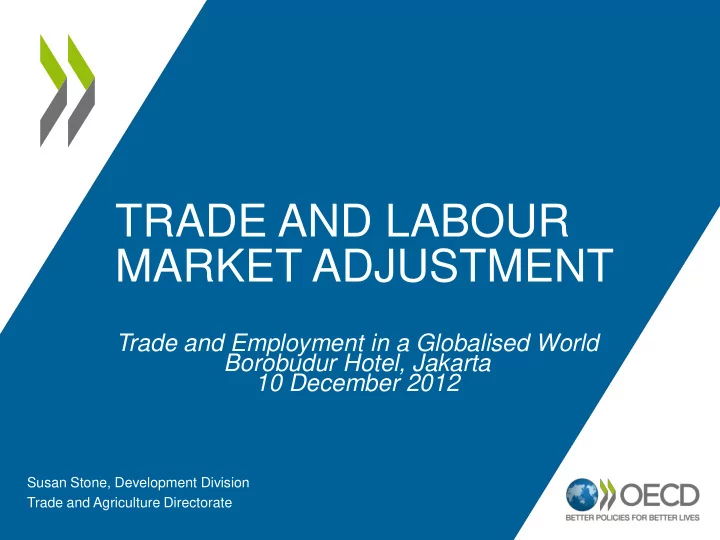

TRADE AND LABOUR MARKET ADJUSTMENT Trade and Employment in a Globalised World Borobudur Hotel, Jakarta 10 December 2012 Susan Stone, Development Division Trade and Agriculture Directorate
How does Trade affect Labour Markets? • Traditionally, labour market impacts from increases in trade were analysed in the context of one representative firm and one representative worker, differentiated by sector/industry, operating in perfectly mobile labour markets. • More recently that has changed to include ‘heterogeneous’ firms, labour market frictions and worker differentiation (eg by skill, age, etc). • This work looks at ‘heterogeneous’ workers, and redefines the relationship so that trade outcomes are attached to occupations rather than industries. OECD Trade and Agriculture Directorate 2
Results There is a difference in labour market impacts/adjustment looking • at occupations rather than industries. – Occupation results show a greater diversity of outcomes and these outcomes are more in line with recent research. The impacts are consistent with new work being done allowing for • differentiated firm behaviour. – Brings to light the potential impact of firm selection on employment and wages generated from firm specific characteristics. • The results are consistent with theories of labour market frictions. – The effects of asymmetric information, hysteresis, etc. on labour market adjustment differs among workers. OECD Trade and Agriculture Directorate 3
Structure of the Work • Harmonised labour force surveys of six economies – 4 OECD and 2 Key Partners: – Brazil, Canada, Israel, South Africa, the United Kingdom (UK) and the United States (US). • Matched with industry measures of trade exposure: – Import Penetration, Export Share and Offshoring. • Examined the relationship between trade exposure and key labour market outcomes: – Unemployment and wages (and duration where available). • Examined these impacts controlling for individual characteristics. OECD Trade and Agriculture Directorate 4
Trade and Adjustment • Labour Markets can adjust to the market changes brought about by greater openness, here measured through: – Imports as a share of domestic demand, – Exports as a share of total production, and – Offshoring, proxied as the share of imported intermediate inputs in total intermediate demand. • Labour market adjustments measured through: – Changes in the probability of becoming unemployed. – Changes in wages received. OECD Trade and Agriculture Directorate 5
Empirical work • Applied basic methodology of Ebenstein , et al (2012), Trefler and Zhui (2011) and others. • Used individual information to: – Create occupation-specific trade measures. – Differentiate impacts by skill level. – Control for worker characteristics. • Applied to cross country sample to compare outcomes. – Reporting outcomes for Brazil and South Africa. OECD Trade and Agriculture Directorate 6
Empirical Work, continued • Developed transition matrices which measure the probability of moving from one state - here (un)employment – to another. • Ran individual country and pooled regressions on wages measured at occupation and industry levels. • Ran individual country and pooled probit (probability) analysis on unemployment at occupation and industry levels. OECD Trade and Agriculture Directorate 7
Transition Matrices • The probability of moving from employment to unemployment (RED) Note: Includes Brazil, Canada, Israel, South Africa and United States OECD Trade and Agriculture Directorate 8
Transition Matrices, continued • Probability of staying unemployment (RED) Note: Includes Brazil, Canada, Israel, South Africa and United States OECD Trade and Agriculture Directorate 9
Comparing industry and occupation outcomes for Unemployment OECD Trade and Agriculture Directorate 10
How do Exports affect the Probability of becoming Unemployed? Skill1 Skill2 Skill3 Skill4 Exports Measured Across Industries Skill1 Skill2 Skill3 Skill4 Exports Measured Across Occupations OECD Trade and Agriculture Directorate 11
How do Imports affect the Probability of becoming Unemployed? Skill1 Skill2 Skill3 Imports Measured Across Industries Skill1 Skill1 Skill2 Skill3 Skill4 Imports Measured Across Occupations OECD Trade and Agriculture Directorate 12
How does Offshoring affect the Probability of becoming Unemployment Skill1 Skill2 Skill3 Skill4 Offshoring Measured Across Industries Skill1 Skill2 Skill3 Skill4 Offshoring Measured Across Occupations OECD Trade and Agriculture Directorate 13
Comparing industry and occupation outcomes for Wages OECD Trade and Agriculture Directorate 14
How does Exporting affect Wages? Skill1 Skill2 Skill3 Skill4 OECD Trade and Agriculture Directorate 15
How does Importing affect Wages? Skill1 Skill2 Skill3 Skill4 OECD Trade and Agriculture Directorate 16
How does Offshoring affect Wages? Skill1 Skill2 Skill3 Skill4 OECD Trade and Agriculture Directorate 17
Summary • Trade impacts measured at the industry level can miss important details: – Exports (Imports) are associated with positive (negative) labour market outcomes but not for all workers. • Take away messages can be applied to many countries: – Not shown here but general patterns occur across 6 very different economies. OECD Trade and Agriculture Directorate 18
Policy Implications • Industry-targeted assistance may be less effective in addressing adjustment costs. • Policies focused on exports are no guarantee of job creation. • Policies focused on reducing labour market frictions can contribute significantly to reducing adjustment costs. • Adjustment assistance – including trade adjustment - aimed at individuals and/or basic skill sets would be more appropriate. OECD Trade and Agriculture Directorate 19
Thank you for your attention Susan Stone www.oecd.org/trade Trade and Agriculture Directorate 20
Recommend
More recommend